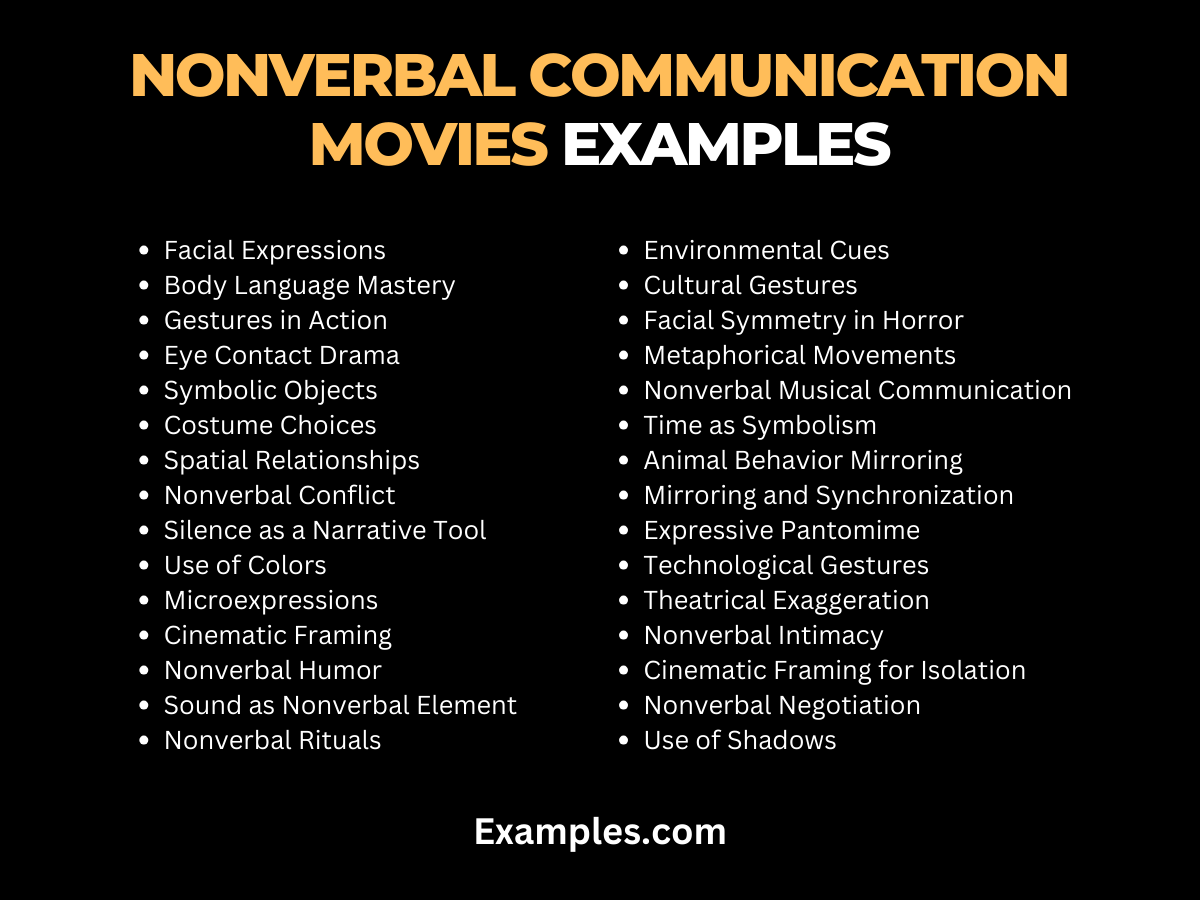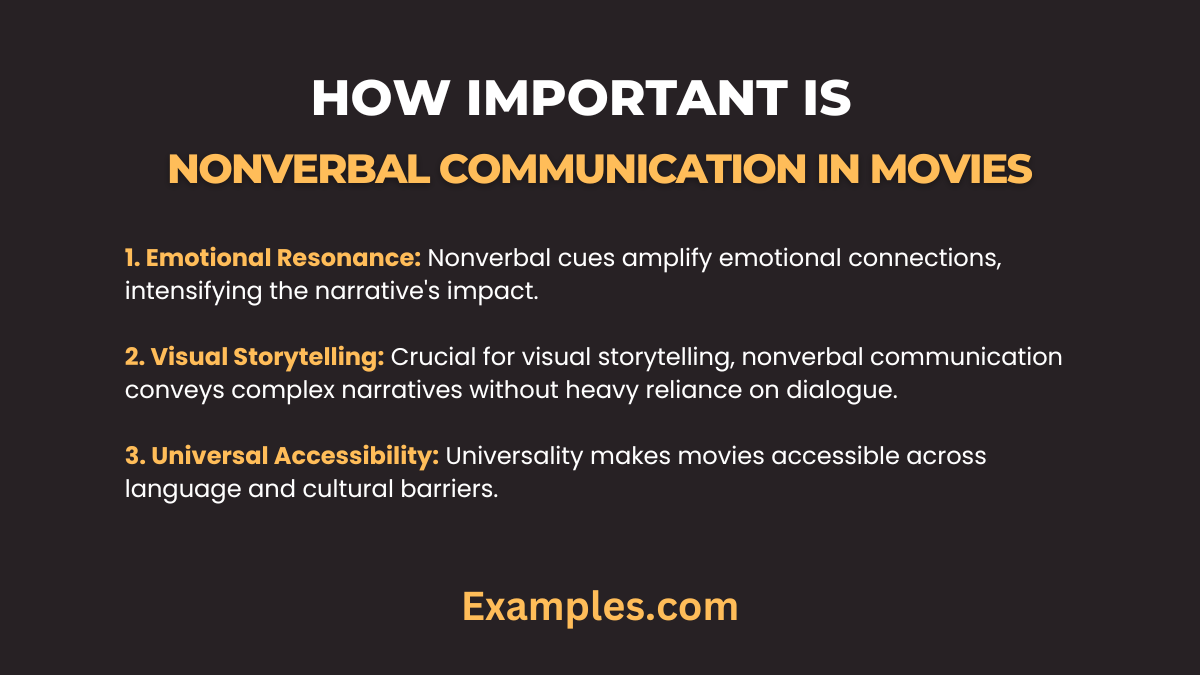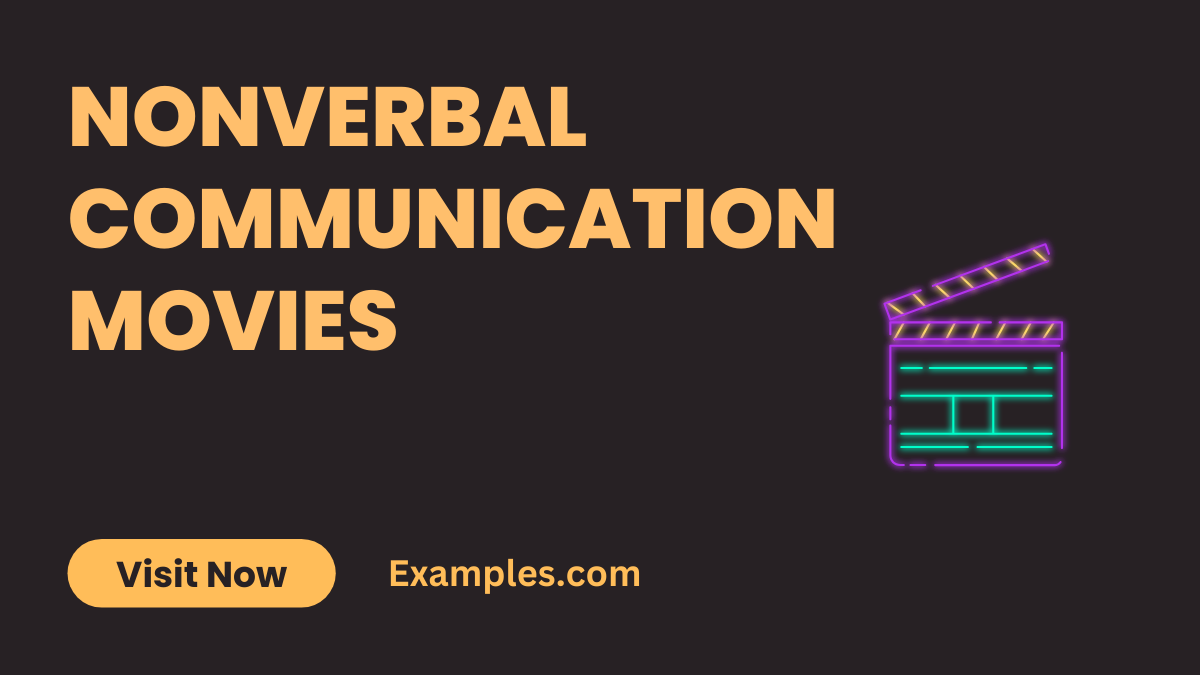29+ Nonverbal Communication In Movies Examples
Embark on a cinematic journey into the subtle yet powerful realm of Nonverbal Communication in Movies. Unravel the nuances of this language, exploring diverse examples that transcend dialogue, enriching the narrative and engaging audiences on a deeper emotional level. Discover how filmmakers masterfully weave nonverbal cues into their storytelling fabric, creating compelling and unforgettable Communication Examples on the silver screen.
What is Nonverbal Communication in Movies?

In the mesmerizing world of cinema, Nonverbal Communication refers to the art of conveying messages, emotions, and narrative elements without relying on spoken words. It encompasses facial expressions, body language, gestures, and visual elements, subtly shaping the audience’s perception and enhancing the storytelling experience. In essence, it’s the silent dialogue between characters and viewers, painting emotions and context on the canvas of the screen.
30 Nonverbal Communication in Movies Examples

Delve into the enchanting world of Nonverbal Communication in Movies, where silence speaks volumes and gestures convey emotions vividly. Each example below showcases the artistry of filmmakers in harnessing the power of the unspoken.
- Facial Expressions: In “The Godfather,” Marlon Brando’s subtle frowns and smiles reveal the complex emotions of his character, Don Vito Corleone.
- Body Language Mastery: Audrey Hepburn’s graceful movements in “Breakfast at Tiffany’s” exemplify the elegance and confidence of her character, Holly Golightly.
- Gestures in Action: The iconic dance scene in “Pulp Fiction” between Uma Thurman and John Travolta communicates desire and tension without a single word.
- Eye Contact Drama: In “Casablanca,” the lingering gaze between Humphrey Bogart and Ingrid Bergman speaks volumes about their unspoken love.
- Symbolic Objects: The red rose in “American Beauty” symbolizes passion and rebellion, adding depth to the film’s nonverbal narrative.
- Costume Choices: Heath Ledger’s portrayal of the Joker in “The Dark Knight” is intensified by his deliberate wardrobe choices, reflecting chaos and anarchy.
- Spatial Relationships: The use of space in “Lost in Translation” accentuates the isolation and connection between characters played by Bill Murray and Scarlett Johansson.
- Nonverbal Conflict: The silent confrontation between characters in “No Country for Old Men” is a masterclass in building tension without dialogue.
- Silence as a Narrative Tool: In “A Quiet Place,” the absence of spoken words becomes a central element, creating an immersive and suspenseful atmosphere.
- Use of Colors: The vibrant red dress in “Schindler’s List” becomes a poignant symbol, contrasting the horrors of the Holocaust.
- Microexpressions: In “Silver Linings Playbook,” Jennifer Lawrence’s fleeting expressions convey a range of emotions, providing insight into her character’s psyche.
- Cinematic Framing: The framing of characters in “Eternal Sunshine of the Spotless Mind” visually communicates the complexity of memory and relationships.
- Nonverbal Humor: Rowan Atkinson’s physical comedy as Mr. Bean transcends language barriers, delivering laughs without uttering a single word.
- Sound as Nonverbal Element: In “2001: A Space Odyssey,” the use of music and sound heightens the emotional impact of pivotal scenes.
- Nonverbal Rituals: The ritualistic dance scenes in “La La Land” convey emotions and tell a story beyond the spoken lines.
- Environmental Cues: The changing weather in “The Shawshank Redemption” symbolizes hope, freedom, and transformation.
- Cultural Gestures: Jackie Chan’s martial arts choreography in “Drunken Master” communicates cultural nuances and storytelling in each move.
- Facial Symmetry in Horror: The unsettling use of facial symmetry in “The Shining” contributes to the eerie atmosphere and psychological horror.
- Metaphorical Movements: The balletic fight scenes in “Crouching Tiger, Hidden Dragon” merge action and poetry, transcending verbal communication.
- Nonverbal Musical Communication: The conductor’s gestures in “Whiplash” symbolize power dynamics and intense emotion in the world of music.
- Time as Symbolism: The ticking clock in “Dunkirk” becomes a nonverbal countdown, intensifying the suspense of the war film.
- Animal Behavior Mirroring: The mimicking dance between Belle and Beast in “Beauty and the Beast” symbolizes their growing connection.
- Mirroring and Synchronization: The synchronized movements of the heist crew in “Ocean’s Eleven” convey teamwork and coordination.
- Expressive Pantomime: Marcel Marceau’s silent performance in “Silent Movie” epitomizes the art of nonverbal communication on and off the screen.
- Technological Gestures: Tom Hanks’ emotional interaction with a volleyball in “Cast Away” showcases the profound impact of nonverbal communication in isolation.
- Theatrical Exaggeration: In “Amélie,” the exaggerated facial expressions and actions add whimsy and charm to the film’s narrative.
- Nonverbal Intimacy: The dance sequence in “Dirty Dancing” conveys a burgeoning romance, emphasizing connection through movement.
- Cinematic Framing for Isolation: The use of wide shots and isolated settings in “The Revenant” visually communicates the harshness of survival.
- Nonverbal Negotiation: The chess game in “The Thomas Crown Affair” becomes a symbolic exchange, conveying strategy and tension.
- Use of Shadows: In “Blade Runner,” the strategic use of shadows enhances the film’s dystopian atmosphere and nonverbal storytelling.
Nonverbal Communication in Movies Examples for Students
Explore cinematic lessons in Nonverbal Communication tailored for students. Iconic films employ expressive facial cues, the power of silence, and symbolic gestures, fostering emotional intelligence and communication skills.
- Expressive Facial Cues in “Inside Out”: Pixar’s animation aids students in recognizing and understanding emotions through distinct facial expressions.
- The Power of Silence in “Dead Poets Society”: Robin Williams’ nonverbal teaching methods encourage students to appreciate the impact of quiet reflection.
- Body Language Lessons in “The Karate Kid”: The mentor-student dynamic teaches the unspoken language of confidence and respect through body language.
- Friendship Nonverbal Bonds in “Stand by Me”: Shared glances and subtle nods illustrate the strength of nonverbal bonds among friends.
- Nonverbal Conflict in “Harry Potter”: Facial expressions and gestures impart lessons on navigating conflicts without words.
- Cinematic Framing in “The Breakfast Club”: Visual elements teach students about the impact of cinematic framing on perceptions and character dynamics.
- Symbolism in “The Lion King”: Nonverbal symbols convey leadership qualities, providing a visual lesson in leadership for students.
- Metaphorical Movements in “Finding Nemo”: Characters’ underwater journey mirrors life’s challenges, offering a lesson in metaphorical storytelling.
- Nonverbal Communication Technology in “The Social Network”: The impact of nonverbal cues in a digital age prompts students to reflect on virtual communication nuances.
- Environmental Cues in “The Lord of the Rings”: Landscapes convey nonverbal messages about characters’ journeys, teaching students about environments in storytelling.
Nonverbal Communication in Movies Examples in Real Life
Uncover real-life reflections through Nonverbal Communication in Movies. From family dynamics to job interviews, these examples bridge fiction and reality, providing insights applicable to everyday communication.
- Family Dynamics in “Little Miss Sunshine”: Characters’ interactions mirror real-life family dynamics, showcasing communication complexities.
- First Impressions in “La La Land”: The film emphasizes the impact of first impressions, prompting viewers to consider nonverbal cues in their own lives.
- Romantic Gestures in “The Notebook”: Nonverbal expressions of love resonate with real-life romantic relationships, illustrating the power of unspoken connection.
- Job Interviews in “The Pursuit of Happyness”: Will Smith’s character exemplifies nonverbal cues in job interviews, offering a realistic portrayal.
- Conflict Resolution in “A Few Good Men”: Intense courtroom scenes mirror real-life conflict resolution challenges and strategies.
- Nonverbal Communication Styles in “The Devil Wears Prada”: Diverse communication styles prompt viewers to reflect on their own preferences and adaptability.
- Subtle Manipulation in “Gone Girl”: Characters’ manipulation tactics serve as a cautionary example in real-life relationships.
- Expressive Nonverbal Responses in “Forrest Gump”: Tom Hanks’ character teaches about the power of genuine nonverbal responses.
- Group Dynamics in “Ocean’s Thirteen”: Nonverbal teamwork reflects real-life group dynamics and the importance of coordination.
- Cultural Misunderstandings in “Lost in Translation”: The film explores the impact of cultural nuances on nonverbal communication, prompting viewers to consider cross-cultural interactions.
Nonverbal Communication in Movies Examples at Workplace
Unlock workplace secrets through Nonverbal Communication in Movies. These examples provide valuable insights into professional interactions, offering lessons in leadership, teamwork, and effective communication.
- Leadership Presence in “The Wolf of Wall Street”: Leonardo DiCaprio’s character demonstrates leadership through nonverbal cues in a corporate setting.
- Negotiation Tactics in “Glengarry Glen Ross”: Intense negotiation scenes showcase the power of nonverbal persuasion in business transactions.
- Team Collaboration in “Moneyball”: Nonverbal teamwork highlights the importance of collaboration and unified goals in the workplace.
- Professional Etiquette in “The Devil’s Advocate”: Nonverbal comportment underscores the significance of professional etiquette in the workplace.
- Conflict Resolution Strategies in “12 Angry Men”: Diverse nonverbal approaches to conflict resolution prompt viewers to reflect on effective strategies at work.
- Nonverbal Impact of Technology in “The Social Network”: The film explores the influence of nonverbal cues in the tech industry, offering insights into virtual communication dynamics at work.
- Interpersonal Dynamics in “The Intern”: The film depicts intergenerational workplace interactions, showcasing the role of nonverbal cues in building positive relationships among colleagues.
- Expressive Communication in “The Pursuit of Happyness”: Will Smith’s character navigates professional challenges with expressive nonverbal communication.
- Communication Styles in “The Devil Wears Prada”: Diverse communication styles illustrate workplace dynamics, emphasizing the need for adaptability and understanding.
- Body Language in “The Big Short”: The film explores the financial industry, highlighting the significance of body language and nonverbal cues in high-pressure workplace environments.
How is Nonverbal Communication used in Movies?
Nonverbal communication in movies is a nuanced storytelling element, essential for conveying emotions, plot developments, and character dynamics without relying on spoken words. Here’s a concise exploration of its effective use in cinema:
- Facial Expressions and Emotions: Actors’ expressions—subtle smiles, furrowed brows.
- Body Language and Gestures: Characters’ movements and gestures speak volumes.
- Cinematic Framing and Composition: Visual elements—framing, composition.
- Use of Symbolism and Metaphors: Symbols and metaphors in movies add depth.
- Silence and Pause: Strategic silence and pauses create tension.
Why is Nonverbal Communication Important in Movies?

Nonverbal communication’s significance goes beyond aesthetics, serving as a powerful tool for engagement and captivation. Here’s a brief understanding:
- Emotional Resonance: Nonverbal cues amplify emotional connections, intensifying the narrative’s impact.
- Visual Storytelling: Crucial for visual storytelling, nonverbal communication conveys complex narratives without heavy reliance on dialogue.
- Universal Accessibility: Universality makes movies accessible across language and cultural barriers.
- Subtlety and Nuance: Adds subtlety, encouraging viewers to draw their own conclusions from layered meanings.
- Character Depth and Development: Enriches characters by revealing emotions, habits, and inner conflicts nonverbally.
- Enhanced Atmosphere and Mood: Shapes scenes through nonverbal cues, setting tones of tension, suspense, or lightheartedness.
- Efficient Storytelling: Allows efficient conveyance of information, relationships, and plot developments within limited timeframes.
- Audience Engagement: Viewer engagement increases as they actively participate in decoding the story through nonverbal cues.
Is Silent Movie an Example of Nonverbal Communication?
Silent movies serve as compelling examples of nonverbal communication. In the absence of spoken words, these films rely entirely on visual cues, facial expressions, body language, and gestures to convey intricate narratives. Characters express emotions, relationships unfold, and conflicts resolve, all without uttering a single word. The silent movie era, marked by classics like “City Lights” and “Metropolis,” highlights the richness of nonverbal communication, proving that cinematic stories can transcend language barriers through masterful visual expression.
Tips for Effective Nonverbal Communication in Movies
Mastering nonverbal communication in movies is an art that enhances storytelling. Filmmakers employ various techniques to convey emotions and messages without explicit dialogue:
- Facial Expressions and Body Language: Actors’ subtle movements and gestures can speak volumes.
- Cinematic Framing: Proper framing influences viewer perception.
- Symbolic Imagery: Effective use of symbols and metaphors adds layers to the narrative
- Sound and Silence: Strategic use of silence, accompanied by music or ambient sounds
- Spatial Relationships: Utilizing space and proximity between characters communicates interpersonal dynamics and relationships.
In conclusion, nonverbal communication in movies plays a pivotal role in storytelling, often conveying complex emotions and narratives without a single spoken word, consider reviewing the literature on the influence of various nonverbal channels on film success. This review, available at Concordia University, St. Paul Digital Commons, dives into the elements of environment, physical characteristics, gestures, and more, revealing how they contribute to both the critical and commercial success of films.
Additionally, Universal Class offers insights on the various forms of nonverbal communication, including body language, gestures, and physical appearance, and their role in effective communication. This information can be found in their detailed article, The Role of Nonverbal Communication in Effective Communication, which provides a comprehensive view on how nonverbal cues are integral to conveying messages in various contexts, including cinema.



